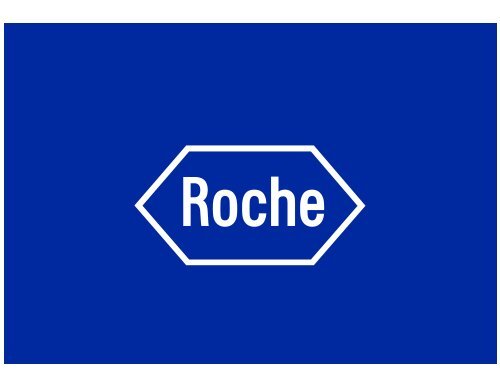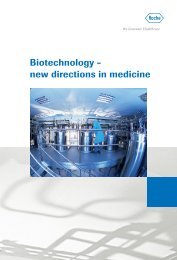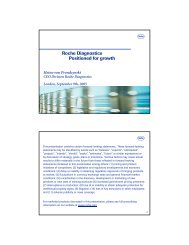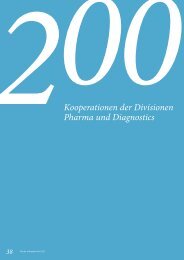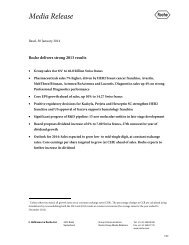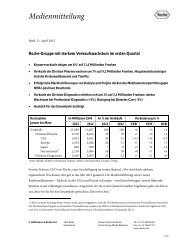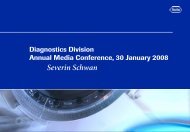Presentation as PDF - Roche
Presentation as PDF - Roche
Presentation as PDF - Roche
You also want an ePaper? Increase the reach of your titles
YUMPU automatically turns print PDFs into web optimized ePapers that Google loves.
This presentation contains certain forward-looking statements.<br />
These forward-looking statements may be identified by words such<br />
<strong>as</strong> “believes”, “expects”, “anticipates”, “projects”, “intends”, “should”,<br />
“seeks”, “estimates”, “future” or similar expressions or by discussion<br />
of strategy, goals, plans or intentions. Various factors may cause actual<br />
results to differ materially in the future from those reflected in forward-looking statements<br />
contained in this presentation among others:<br />
1. Pricing and product initiatives of competitors;<br />
2. Legislative and regulatory developments and economic conditions;<br />
3. Delay or inability in obtaining regulatory approvals or bringing products to market;<br />
4. Fluctuations in currency exchange rates and general financial market conditions;<br />
5. Uncertainties in the discovery, development or marketing of new products or new uses of existing<br />
products;<br />
6. Incre<strong>as</strong>ed government pricing pressures;<br />
7. Interruptions in production;<br />
8. Loss of or inability to obtain adequate protection for intellectual property rights;<br />
9. Litigation;<br />
10. Loss of key executives or other employees; and...<br />
11. Adverse publicity or news coverage<br />
For marketed products discussed in this presentation, ple<strong>as</strong>e see full prescribing information on our<br />
website – www.roche.com<br />
2
ASCO 2007 Investor Event<br />
Chicago, June 4, 2007<br />
Introduction<br />
Karl Mahler, Head Investor Relations
Moving the standards of care<br />
Making a difference for patients<br />
• Introduction<br />
Dr. Karl Mahler - Head of Investor Relations, <strong>Roche</strong><br />
• Pertuzumab Ph<strong>as</strong>e II in mBC<br />
Prof. Dr. José B<strong>as</strong>elga - Vall d’Hebron University Hospital, Barcelona<br />
• Setting the standards of care for treatment of cancer<br />
Dr. Kapil Dhingra - VP Medical Science, <strong>Roche</strong><br />
• AVOREN: The role of Av<strong>as</strong>tin in Renal Cancer<br />
Prof. Dr. Bernard Escudier – Institut Gustave Roussy, Paris<br />
• Q&A<br />
4
<strong>Roche</strong> oncology 2000-2006<br />
Established <strong>as</strong> market leader<br />
Kytril: global<br />
rights acquisition<br />
CHF<br />
bn<br />
Herceptin: EU<br />
mBC<br />
1.6<br />
Xeloda: US/EU<br />
mCRC<br />
NeoRecorm: EU<br />
hem. maligs<br />
2.8<br />
Bondronat: EU<br />
met<strong>as</strong>tatic bone dise<strong>as</strong>e<br />
MabThera: EU<br />
aNHL<br />
Xeloda: EU<br />
mBC<br />
4.5<br />
5.3<br />
Tarceva: US<br />
NSCLC<br />
MabThera: EU<br />
1st line iNHL<br />
Herceptin: EU<br />
Taxotere combo<br />
NeoRecormon: EU<br />
once-weekly<br />
Av<strong>as</strong>tin: US<br />
mCRC<br />
2000 2001 2002 2003 2004 2005 2006<br />
6.9<br />
Xeloda: EU<br />
adj CC<br />
Tarceva: US<br />
Pancreatic<br />
Tarceva: EU<br />
NSCLC<br />
Xeloda: US<br />
adj CC<br />
Av<strong>as</strong>tin: EU<br />
mCRC<br />
10.2<br />
Herceptin: EU/US<br />
adj BC<br />
MabThera: EU/US<br />
NHL maint.<br />
Av<strong>as</strong>tin: US<br />
NSCLC<br />
14.6<br />
MabThera<br />
Herceptin<br />
Xeloda<br />
Av<strong>as</strong>tin<br />
Tarceva<br />
Kytril<br />
Bondronat<br />
NeoRecorm.<br />
anti-tumor<br />
supportive<br />
care<br />
5
Changes in the oncology market<br />
Significant therapeutic progress over the l<strong>as</strong>t decade<br />
• Research activities over the p<strong>as</strong>t years have resulted in substantial incre<strong>as</strong>es in<br />
approved oncology drugs<br />
– 1950- 1960: 11<br />
– 1990-2000: > 50<br />
– 2000-2005: > 80<br />
• New generation of oncology products: biologics and targeted therapies<br />
• <strong>Roche</strong> h<strong>as</strong> set the standard<br />
6
Our strategy<br />
• Build on our excellent products with proven safety and efficacy<br />
• Improve the standard of care<br />
– With new combinations<br />
– In multiple cancer types<br />
• Move products from ‘potentially life extending’ to ‘potentially life saving’<br />
• Make use of our first mover advantage - keep the lead<br />
7
ASCO 2007 Investor Event<br />
Chicago, June 4, 2007<br />
Pertuzumab in HER2-positive met<strong>as</strong>tatic bre<strong>as</strong>t cancer<br />
J. B<strong>as</strong>elga, Vall d’Hebron University Hospital, Barcelona
Tr<strong>as</strong>tuzumab and pertuzumab<br />
Binding to distinct epitopes on HER2 extracellular domain<br />
Tr<strong>as</strong>tuzumab<br />
Pertuzumab<br />
• Activates antibody-dependent cellular<br />
cytotoxicity<br />
• Enhances HER2 internalization<br />
• Inhibits shedding and therefore formation<br />
of p95<br />
• Inhibits HER2-regulated angiogenesis<br />
Hubbard 2005<br />
• Activates antibody-dependent cellular<br />
cytotoxicity<br />
• Prevents receptor dimerization<br />
• Potent inhibitor of HER-mediated signaling<br />
pathways<br />
9
Ph<strong>as</strong>e II Trial of pertuzumab + tr<strong>as</strong>tuzumab in<br />
HER2-positive patients progressing on tr<strong>as</strong>tuzumab<br />
Two-stage design<br />
YES<br />
Stage 2 (n=58)<br />
Stage 1 (n=24)<br />
Tr<strong>as</strong>tuzumab +<br />
pertuzumab a<br />
≥2 R or 1 R + 12 SD<br />
or 13 SD<br />
Safety evaluation<br />
for IDSMB<br />
NO<br />
Stop trial<br />
a<br />
T: 4 mg/kg loading dose 2 mg/kg qw or 8 mg/kg loading dose 6 mg/kg q3w;<br />
P: 840 mg loading dose 420 mg q3w<br />
IDSMB, International Data and Safety Monitoring Board<br />
10
Study objectives<br />
Primary<br />
• Efficacy<br />
• Safety<br />
– response rate + stabilization of dise<strong>as</strong>e = clinical benefit rate<br />
– evaluate safety of combined antibody treatment<br />
Secondary<br />
• Biomarker evaluation<br />
– qRT-PCR panel: EGFR, HER2, HER3, beta-cellulin, amphiregulin<br />
– serum marker panel: HER2 extracellular domain, TGF-alpha, EGF,<br />
amphiregulin<br />
11
Main eligibility criteria<br />
• HER2-positive bre<strong>as</strong>t cancer (IHC 3+ / FISH+ centrally confirmed) and<br />
availability of tumor samples for biomarker <strong>as</strong>sessment<br />
• Me<strong>as</strong>urable dise<strong>as</strong>e according to RECIST<br />
• Up to 3 lines of prior therapies or chemotherapy and / or tr<strong>as</strong>tuzumab<br />
(including in the adjuvant setting)<br />
• Dise<strong>as</strong>e progression during tr<strong>as</strong>tuzumab <strong>as</strong> most recent treatment for<br />
met<strong>as</strong>tatic dise<strong>as</strong>e<br />
• Study treatment initiated within 9 weeks of the l<strong>as</strong>t dose of tr<strong>as</strong>tuzumab<br />
• B<strong>as</strong>eline LVEF ≥55% and no decre<strong>as</strong>e of LVEF to
Current status<br />
70<br />
Recruitment progress <strong>as</strong> at April 30, 2007<br />
Patients enrolled<br />
60<br />
50<br />
40<br />
30<br />
20<br />
10<br />
Stage 1: 27 patients<br />
have received treatment<br />
Stage 2: 15 (35%) patients<br />
have received treatment<br />
Actual cumulative<br />
Planned cumulative<br />
0<br />
Mar<br />
06<br />
Apr<br />
06<br />
May<br />
06<br />
Jun<br />
06<br />
Jul<br />
06<br />
Aug<br />
06<br />
Sep<br />
06<br />
Oct<br />
06<br />
Nov<br />
06<br />
Dec<br />
06<br />
Jan<br />
07<br />
Feb<br />
07<br />
Mar<br />
07<br />
Apr<br />
07<br />
May<br />
07<br />
Jun<br />
07<br />
Jul<br />
07<br />
• 44 patients randomized, 2 yet to receive treatment<br />
• Safety population n=42 (all patients randomized and received study treatment)<br />
• Efficacy population n=33 (all patients in safety population and had a<br />
post-b<strong>as</strong>eline tumor <strong>as</strong>sessment)<br />
13
Overall adverse events<br />
Adverse event<br />
Diarrhea<br />
Skin (other than r<strong>as</strong>h)<br />
Nausea / vomiting<br />
Mucositis<br />
Pain<br />
R<strong>as</strong>h<br />
Fatigue<br />
Deep vein thrombosis, ejection fraction<br />
decre<strong>as</strong>ed, hypersensitivity, hypertension,<br />
hypomagnesemia<br />
Incidence (%)<br />
24 (57)<br />
15 (35)<br />
14 (33)<br />
14 (33)<br />
14 (33)<br />
12 (28)<br />
13 (31)<br />
1 each (2)<br />
Total number of AEs = 233; patients with at le<strong>as</strong>t 1 AE = 34 (81%)<br />
14
Cardiac safety<br />
10 B<strong>as</strong>eline mean: 61% (SEM 0.81); median 60.5% (range 51-73)<br />
8<br />
Mean Absolute Change in<br />
LVEF (%)<br />
6<br />
4<br />
2<br />
0<br />
-2<br />
-4<br />
-6<br />
Cycle 1<br />
n=33<br />
Cycle 2<br />
n=32<br />
Cycle 4<br />
n=21<br />
Cycle 6<br />
n=18<br />
Cycle 8<br />
n=13<br />
Cycle 12<br />
n=4<br />
-8<br />
-10<br />
15
Efficacy data<br />
Best overall response<br />
Response<br />
Complete response<br />
Partial response<br />
Overall response rate<br />
Stable dise<strong>as</strong>e for 6 months<br />
(≥ cycle 8)<br />
Clinical benefit rate<br />
Stable dise<strong>as</strong>e<br />
(
Efficacy data<br />
Best overall response over time<br />
Cycle<br />
BL<br />
2<br />
4<br />
6<br />
8<br />
12<br />
Tumor <strong>as</strong>sessments<br />
completed (n)<br />
42<br />
33<br />
20 a<br />
19<br />
12<br />
4<br />
Best confirmed<br />
overall response<br />
Complete response<br />
Partial response<br />
Stable dise<strong>as</strong>e<br />
3<br />
6<br />
1<br />
4<br />
1<br />
1<br />
6<br />
1<br />
a<br />
Earliest scheduled opportunity for confirmed response<br />
BL, b<strong>as</strong>eline<br />
17
Responding patients<br />
Characteristics<br />
Age (years)<br />
76<br />
54<br />
55<br />
45<br />
49<br />
57<br />
ER / PgR status<br />
+ / -<br />
-/ NK<br />
+ / +<br />
-/ -<br />
+ / NK<br />
-/ -<br />
Previous chemotherapy<br />
2<br />
1<br />
1<br />
2<br />
2<br />
2<br />
Site of target lesions<br />
LNs<br />
Liver<br />
LNs<br />
Liver<br />
LNs<br />
Skin<br />
LNs<br />
Sum of lesions at BL<br />
(mm)<br />
27<br />
105<br />
28<br />
103<br />
61<br />
588<br />
Site of non-target<br />
lesions<br />
LNs<br />
Liver<br />
Bone<br />
LNs<br />
Liver<br />
Bone<br />
Skin<br />
Response status<br />
PR<br />
PR<br />
CR<br />
PR<br />
PR<br />
PR<br />
CR, complete response; LNs, lymph nodes; NK, not known; PgR, progesterone receptor;<br />
PR, partial response<br />
18
Conclusions<br />
• Pertuzumab, the first HER2 dimerization inhibitor, a new cl<strong>as</strong>s of anti-HER2<br />
therapies<br />
• Pertuzumab is active and well tolerated when given with tr<strong>as</strong>tuzumab in<br />
patients with HER2 overexpressing bre<strong>as</strong>t cancer with documented<br />
progression on tr<strong>as</strong>tuzumab <strong>as</strong> l<strong>as</strong>t therapy<br />
• Accrual is ongoing (planned recruitment: 58 evaluable patients)<br />
• Biomarker research is being conducted and may help to identify patients most<br />
likely to benefit<br />
• Pertuzumab is a valuable addition to anti-HER2 agents. Further studies are<br />
being planned in early and advanced HER2-overexpressing bre<strong>as</strong>t cancer<br />
19
ASCO 2007 Investor Event<br />
Chicago, June 4, 2007<br />
Setting the standards of care for treatment of cancer<br />
Dr. Kapil Dhingra, VP Medical Science
<strong>Roche</strong> products<br />
Key components of the standards of care in major indications<br />
2 nd l.<br />
Xeloda,<br />
Av<strong>as</strong>tin<br />
2 nd l.<br />
Xeloda,<br />
Av<strong>as</strong>tin<br />
2 nd<br />
3 rd line<br />
Tarceva<br />
Maint<br />
enance<br />
MabThera<br />
1 st line<br />
Xeloda, Av<strong>as</strong>tin<br />
Adjuvant<br />
Xeloda, Av<strong>as</strong>tin<br />
1 st line<br />
Xeloda,<br />
Herceptin, Av<strong>as</strong>tin<br />
Adjuvant<br />
Herceptin, Av<strong>as</strong>tin, Xeloda<br />
1 st line<br />
Av<strong>as</strong>tin,Tarceva<br />
Adjuvant<br />
Tarceva, Av<strong>as</strong>tin<br />
2 nd line<br />
MabThera<br />
Maintenance<br />
MabThera<br />
1 st line<br />
MabThera, Av<strong>as</strong>tin<br />
CRC<br />
BC NSCLC NHL<br />
Proven efficacy<br />
In development<br />
Development in preparation<br />
21
Bre<strong>as</strong>t Cancer<br />
Colorectal Cancer<br />
Non-Small Cell Lung Cancer<br />
Non Hodgkin‘s Lymphoma<br />
Renal Cell Carcinoma<br />
Outlook<br />
22
Herceptin<br />
Standard of care for HER2-positive bre<strong>as</strong>t cancer<br />
Proven overall survival benefit in met<strong>as</strong>tatic BC<br />
• 4.8 months median survival for H + all chemotherapy (from 20.3 to 25.1 months)<br />
• 8.5 months median survival benefit for H + Docetaxel (from 22.7 to 31.2 months)<br />
Unprecedented benefit in early BC<br />
• Risk of dise<strong>as</strong>e recurrence halved<br />
• Risk of death reduced by a third<br />
• Consistent across four large trials<br />
Well-established safety record<br />
• 10 years of clinical experience in nearly 400,000 patients<br />
Most effective HER2-targeting agent<br />
23
Neoadjuvant Herceptin (NOAH)<br />
Improve outcome by reducing tumor size prior to surgery<br />
H + AT<br />
q3w x 3<br />
n=115<br />
HER2-positive LABC<br />
(IHC 3+ or FISH+)<br />
AT<br />
q3w x 3<br />
n=113<br />
HER2-negative LABC<br />
(IHC 0/1+)<br />
AT<br />
q3w x 3<br />
n=99<br />
H + T<br />
q3w x 4<br />
T<br />
q3w x 4<br />
T<br />
q3w x 4<br />
H q3w x 4<br />
+ CMF d1, d8 q4w x 3<br />
CMF<br />
d1, d8 q4w x 3<br />
CMF<br />
d1, d8 q4w x 3<br />
Surgery<br />
Surgery<br />
Surgery<br />
H continued q3w x 7<br />
Radiotherapy<br />
L. Gianni et al. ASCO 2007<br />
Radiotherapy<br />
Radiotherapy<br />
24
NOAH<br />
Near doubling of pathological complete response<br />
Patients %<br />
50<br />
40<br />
30<br />
20<br />
10<br />
43%<br />
p=0.002<br />
23%<br />
p=0.29<br />
17%<br />
38%<br />
p=0.003<br />
20%<br />
p=0.43<br />
16%<br />
0<br />
+ H - H HER2-<br />
negative<br />
HER2-positive<br />
+ H - H HER2-<br />
negative<br />
HER2-positive<br />
pCR<br />
tpCR<br />
Safety: only one patient with >10% decre<strong>as</strong>e from b<strong>as</strong>eline and
NOAH conclusion<br />
Herceptin’s value in neoadjuvant therapy confirmed<br />
• Compelling anti-tumor activity in primary bre<strong>as</strong>t cancer<br />
• Well tolerated<br />
• Patient benefit:<br />
– Renders inoperable tumors removable<br />
– Results in less inv<strong>as</strong>ive & bre<strong>as</strong>t-conserving surgery in the majority of c<strong>as</strong>es<br />
– Likely to improve survival in a difficult-to-treat population<br />
26
Update on adjuvant trials<br />
NCCTG N9831 / NSAPB B-31 joint efficacy analysis<br />
• Adjuvant chemotherapy with or without Herceptin in HER2-positive early BC<br />
NSABP B-31<br />
(N = 2,085)<br />
AC<br />
AC<br />
paclitaxel<br />
paclitaxel + Herceptin<br />
AC<br />
paclitaxel<br />
NCCTG N9831<br />
(N = 3,406)<br />
AC<br />
AC<br />
paclitaxel<br />
paclitaxel + Herceptin<br />
Herceptin<br />
Patients randomized to AC<br />
eligible to receive Herceptin<br />
T and less than 6 months from completion of chemo were<br />
E. Romond, E. Perez, et al. NEJM 353:16 2005<br />
27
NCCTG N9831 / NSAPB B-31<br />
Joint efficacy analysis of adjuvant trials<br />
2.9 years median follow-up; combined analysis:<br />
• Risk of relapse reduced by 52%<br />
• Risk of death reduced by 35%<br />
Cumulative incidence of cardiac events unchanged<br />
Conclusion<br />
• Substantial improvement in outcomes with the addition of Herceptin to chemo<br />
• Improvement continues despite cross-over after initial results reported<br />
• No incre<strong>as</strong>e in cardiac events with longer follow-up<br />
Further reinforce the use of Herceptin <strong>as</strong> the foundation of care<br />
E. Perez, et al. ASCO 2007<br />
28
Attacking the HER2 pathway from multiple angles<br />
Two next generation products in development<br />
Herceptin<br />
Pertuzumab<br />
Tr<strong>as</strong>tuzumab-DM1<br />
Mechanism<br />
Specifically targeting<br />
HER2<br />
Inhibits HER2-mediated<br />
signalling<br />
First in cl<strong>as</strong>s HER<br />
dimerization inhibitor<br />
Inhibits multiple HERmediated<br />
pathways<br />
Binds to HER2 and<br />
delivers a potent<br />
cytotoxic agent in a<br />
targeted manner<br />
Ph<strong>as</strong>e of<br />
development<br />
Approved for adjuvant<br />
and mBC (HER2+)<br />
Ph<strong>as</strong>e III ‘go’ decision<br />
For mBC (HER2+)<br />
Ph<strong>as</strong>e I<br />
Efficacy data<br />
Survival benefit<br />
In adjuvant and<br />
met<strong>as</strong>tatic<br />
HER2+ BC<br />
18% response rate<br />
39% clinical benefit<br />
rate<br />
Poster at ASCO 2007<br />
ASCO 2007<br />
Unprecedented benefit<br />
confirmed<br />
Exciting early<br />
evidence of efficacy<br />
Fe<strong>as</strong>ible new<br />
treatment concept<br />
29
Key clinical trials in mBC<br />
Herceptin+<br />
Av<strong>as</strong>tin<br />
Av<strong>as</strong>tin<br />
Herceptin+<br />
Pertuzumab<br />
Study<br />
<strong>Roche</strong><br />
AVADO<br />
RIBBON-1<br />
RIBBON-2<br />
Ph<strong>as</strong>e II<br />
ph<strong>as</strong>e III<br />
ph<strong>as</strong>e III<br />
ph<strong>as</strong>e III<br />
ph<strong>as</strong>e III<br />
Patient<br />
population<br />
1 st line<br />
1 st line<br />
1 st line<br />
2 nd line<br />
2nd line Ph II<br />
1st line Ph III<br />
Treatment<br />
regimen<br />
Herceptin +<br />
Docetaxel ±<br />
Av<strong>as</strong>tin<br />
Taxotere ±<br />
Av<strong>as</strong>tin<br />
CT ±<br />
Av<strong>as</strong>tin<br />
CT ±<br />
Av<strong>as</strong>tin<br />
Herceptin ±<br />
Pertuzumab<br />
Status<br />
Started 3Q 2006<br />
Completed<br />
recruitment<br />
Started 4Q<br />
2005<br />
Started 1Q<br />
2006<br />
Ph II results<br />
available<br />
Continuous commitment to advancing the standard of care in mBC<br />
30
Key ongoing/planned clinical trials in adjuvant BC<br />
Xeloda<br />
Av<strong>as</strong>tin<br />
Av<strong>as</strong>tin +<br />
Herceptin<br />
Study<br />
NO17629<br />
E5103<br />
<strong>Roche</strong><br />
<strong>Roche</strong><br />
ph<strong>as</strong>e III<br />
ph<strong>as</strong>e III<br />
ph<strong>as</strong>e III<br />
ph<strong>as</strong>e III<br />
Patient<br />
population<br />
HER2-<br />
ER/PR-<br />
HER2-<br />
HER2-<br />
HER2+<br />
Treatment<br />
regimen<br />
AC Docetaxel<br />
± Xeloda<br />
AC P vs. AC/Av<strong>as</strong>tin<br />
P/Av<strong>as</strong>tin vs. AC/Av<strong>as</strong>tin<br />
é P/Av<strong>as</strong>tin Av<strong>as</strong>tin<br />
up to 12 months<br />
Standard<br />
chemo +/-<br />
Av<strong>as</strong>tin for<br />
12 months<br />
tbd<br />
Status<br />
Recruitment<br />
completed<br />
FPI pending<br />
FPI planned<br />
for 4Q 2007<br />
Protocol in<br />
preparation<br />
Broad program to redefine adjuvant BC treatment<br />
31
Bre<strong>as</strong>t Cancer<br />
Colorectal Cancer<br />
Non-Small Cell Lung Cancer<br />
Renal Cell Carcinoma<br />
Non Hodgkin‘s Lymphoma<br />
Outlook<br />
32
Av<strong>as</strong>tin in 1 st line mCRC<br />
Largest improvement in overall survival in ph<strong>as</strong>e III<br />
1.0<br />
0.8<br />
Median survival (months)<br />
IFL + placebo: 15.6 vs<br />
IFL + Av<strong>as</strong>tin: 20.3<br />
HR = 0.66 (95% CI: 0.54–0.81) p
Key ph<strong>as</strong>e III/IV Av<strong>as</strong>tin trials in mCRC<br />
At ASCO 2007<br />
Av<strong>as</strong>tin+<br />
FOLFIRI<br />
Av<strong>as</strong>tin+<br />
various chemos<br />
Av<strong>as</strong>tin+<br />
various chemos<br />
Av<strong>as</strong>tin +<br />
oxaliplatin b<strong>as</strong>ed<br />
chemos<br />
Study<br />
AVIRI<br />
BEAT<br />
BRiTE<br />
NO16966<br />
Patient<br />
population<br />
1 st line mCRC<br />
1 st line mCRC<br />
1 st line mCRC<br />
1 st line mCRC<br />
Treatment<br />
regimen<br />
FOLFIRI+Av<strong>as</strong>tin<br />
Av<strong>as</strong>tin + current<br />
standard<br />
regimens<br />
Av<strong>as</strong>tin + current<br />
standard<br />
regimens<br />
FOLFOX or XELOX<br />
+<br />
Av<strong>as</strong>tin vs placebo<br />
Status<br />
PFS data at ASCO<br />
2007<br />
Efficacy update<br />
ASCO 2007<br />
Efficacy update<br />
ASCO 2007<br />
Primary endpoint<br />
met<br />
ESMO 2006<br />
34
NO16966<br />
Study design<br />
Recruitment<br />
June 2003 – May 2004<br />
Recruitment<br />
Feb 2004 – Feb 2005<br />
XELOX<br />
N=317<br />
FOLFOX4<br />
N=317<br />
XELOX + placebo<br />
N=350<br />
FOLFOX4 + placebo<br />
N=351<br />
XELOX +<br />
Av<strong>as</strong>tin<br />
N=350<br />
FOLFOX4 +<br />
Av<strong>as</strong>tin<br />
N=349<br />
Initial 2-arm<br />
open-label study (N=634)<br />
Protocol amended to 2x2 placebo-controlled design<br />
after Av<strong>as</strong>tin ph<strong>as</strong>e III data became available<br />
(N=1400)<br />
35
NO16966<br />
Primary objectives<br />
1. Non-inferiority of XELOX vs. FOLFOX-4<br />
2. Superiority of Av<strong>as</strong>tin + chemo (XELOX or FOLFOX-4) vs. placebo + chemo<br />
• Primary endpoint: PFS<br />
36
XELOX non-inferiority<br />
Primary objective met<br />
PFS estimate<br />
1.0<br />
0.8<br />
0.6<br />
0.4<br />
0.2<br />
XELOX / XELOX + placebo / XELOX + Av<strong>as</strong>tin<br />
FOLFOX / FOLFOX + placebo / FOLFOX + Av<strong>as</strong>tin<br />
HR = 1.05 (97.5% CI: 0.94–1.18)<br />
Upper limit below
Av<strong>as</strong>tin superiority<br />
Primary objective met<br />
PFS estimate<br />
1.0<br />
0.8<br />
0.6<br />
0.4<br />
XELOX / FOLFOX + Av<strong>as</strong>tin<br />
XELOX / FOLFOX + Placebo<br />
HR=0.83<br />
(97.5% CI: 0.72-0.95, p=0.0023)<br />
513 events<br />
547 events<br />
0.2<br />
0<br />
8.0m<br />
9.4m<br />
0 3 6 9 12 15 18 21<br />
Months<br />
J. C<strong>as</strong>sidy, et al. ESMO 2006<br />
38
Av<strong>as</strong>tin superiority<br />
Strong benefit from treatment until progression<br />
PFS estimate<br />
1.0<br />
0.8<br />
0.6<br />
0.4<br />
0.2<br />
XELOX / FOLFOX + Av<strong>as</strong>tin<br />
XELOX / FOLFOX + Placebo<br />
ON TREATMENT: HR=0.64<br />
(97.5% CI 0.53–0.76, p
NO16966: Secondary endpoint OS<br />
1.0<br />
0.8<br />
XELOX / FOLFOX-4 + Av<strong>as</strong>tin<br />
XELOX / FOLFOX-4 + placebo<br />
HR=0.89<br />
(97.5% CI 0.76–1.03, p=0.0769)<br />
n=699; 420 events<br />
n=701; 455 events<br />
OS estimate<br />
0.6<br />
0.4<br />
0.2<br />
0<br />
19.9 21.3<br />
0 6 12 18 24 30 36<br />
Strong survival trend despite Months suboptimal use of Av<strong>as</strong>tin<br />
40
The AVIRI study<br />
FOLFIRI + Av<strong>as</strong>tin in mCRC<br />
1st line met<strong>as</strong>tatic CRC<br />
(n=209)<br />
Av<strong>as</strong>tin<br />
plus FOLFIRI<br />
PD<br />
International multicenter trial, open label,<br />
31 centres<br />
Primary endpoint: progression-free survival<br />
AF. Sobrero et al. ASCO 2007<br />
41
The AVIRI study<br />
Excellent efficacy for Av<strong>as</strong>tin + FOLFIRI<br />
Parameter<br />
All pts (n=209)<br />
Progression-free survival<br />
11.1 months<br />
Overall response rate<br />
53.1%<br />
Overall tumor control<br />
85.6%<br />
AF. Sobrero et al. ASCO 2007<br />
42
FOLFIRI in 1st line mCRC<br />
High response rates with Av<strong>as</strong>tin<br />
Parameter<br />
FOLFIRI + Av<strong>as</strong>tin<br />
(AVIRI)<br />
FOLFIRI + Av<strong>as</strong>tin<br />
(MD Anderson)<br />
FOLFIRI + Av<strong>as</strong>tin<br />
(BICC-C)<br />
FOLFIRI + Cetuximab<br />
(CRYSTAL)<br />
Overall Response Rate<br />
53.1%<br />
62.0%<br />
47.0%<br />
46.9%<br />
43
FOLFIRI in 1st line mCRC<br />
Excellent progression free survival with Av<strong>as</strong>tin<br />
Douillard<br />
Tournigand<br />
CRYSTAL<br />
BEAT<br />
BRiTE<br />
AVIRI<br />
MD Anderson<br />
BICC-C<br />
FOLFIRI<br />
FOLFIRI<br />
FOLFIRI + Cetuximab<br />
FOLFIRI + Av<strong>as</strong>tin<br />
FOLFIRI + Av<strong>as</strong>tin<br />
FOLFIRI + Av<strong>as</strong>tin<br />
FOLFIRI + Av<strong>as</strong>tin<br />
FOLFIRI + Av<strong>as</strong>tin<br />
n=109<br />
n=104<br />
n=608<br />
n=503<br />
n=280<br />
n=209<br />
n=41<br />
n=57<br />
0 2.5 5 7.5 10 12.5<br />
Months<br />
44
Av<strong>as</strong>tin in 1st line mCRC<br />
BRiTE – A large observational study<br />
1st line met<strong>as</strong>tatic CRC<br />
(n=1,953)<br />
Av<strong>as</strong>tin plus<br />
chemotherapy<br />
Multicenter trial, open label, US territory<br />
Chemotherapy backbone at discretion of investigator<br />
Objectives: Safety and efficacy<br />
Option to continue Av<strong>as</strong>tin beyond progression at the discretion of the<br />
investigator<br />
A. Grothey et al. ASCO 2007<br />
45
BRiTE: post 1st progression therapy<br />
Av<strong>as</strong>tin beyond progression: potential to incre<strong>as</strong>e survival<br />
No post PD treatment<br />
n=253<br />
No Av<strong>as</strong>tin post PD<br />
n=531<br />
Av<strong>as</strong>tin post PD<br />
n=642 31.8<br />
A. Grothey et al. ASCO 2007<br />
0 5 10 15 20 25 30<br />
Months<br />
Superior survival in patients continuing Av<strong>as</strong>tin beyond progression demonstrated<br />
in a multivariate analysis (HR=0.53, p < 0.001)<br />
46
Combinations in met<strong>as</strong>tatic colorectal cancer<br />
Expanding the market for Xeloda and Av<strong>as</strong>tin<br />
Av<strong>as</strong>tin<br />
Current EU label: iv 5-FU or<br />
5-FU + Irinotecan-b<strong>as</strong>ed tx<br />
Future label: + any combination<br />
Xeloda<br />
Current label: Monotherapy<br />
Future label: extended to oxaliplatinb<strong>as</strong>ed<br />
therapy plus/minus Av<strong>as</strong>tin<br />
Xeloda<br />
14%<br />
5-FU<br />
8%<br />
52%<br />
Xeloda<br />
14%<br />
Oxaliplatinb<strong>as</strong>ed<br />
52%<br />
Irinotecanb<strong>as</strong>ed<br />
25%<br />
5-FU<br />
8%<br />
Oxaliplatinb<strong>as</strong>ed<br />
Irinotecanb<strong>as</strong>ed<br />
25%<br />
47
Av<strong>as</strong>tin: aiming for cure in mCRC<br />
Excellent safety and efficacy results in patients not optimal<br />
candidates for primary liver resection<br />
Response<br />
Overall response rate<br />
Complete pathological response<br />
Resection rate<br />
Patients (n=54)<br />
74%<br />
9%<br />
90%<br />
Peri- and post-operative events:<br />
• No incre<strong>as</strong>ed bleeding<br />
• Normal liver regeneration<br />
• One patient required further surgery<br />
B. Gruenberger et al. ASCO 2007<br />
48
Av<strong>as</strong>tin in mCRC<br />
Strong and clinically meaningful efficacy<br />
Four randomized ph<strong>as</strong>e III trials show compelling efficacy<br />
• AVF2107g<br />
• E3200<br />
• AVF2192<br />
• NO16966<br />
AVIRI / BICC-C / MD Anderson<br />
• Av<strong>as</strong>tin + FOLFIRI investigated in more than 1000 patients<br />
• Demonstrates excellent PFS results and response rates<br />
BRiTE<br />
• Initial evidence of benefit from Av<strong>as</strong>tin in multiple lines of therapy<br />
Aiming for cure<br />
• Excellent safety and efficacy results in patients not optimal candidates for primary liver<br />
resection<br />
49
Bre<strong>as</strong>t Cancer<br />
Colorectal Cancer<br />
Non-Small Cell Lung Cancer<br />
Non Hodgkin‘s Lymphoma<br />
Renal Cell Carcinoma<br />
Outlook<br />
50
Av<strong>as</strong>tin in 1 st line NSCLC (E4599)<br />
First drug in a decade to show an overall survival benefit<br />
1.0<br />
0.8<br />
PC + Av<strong>as</strong>tin<br />
PC<br />
12 mo. 24 mo.<br />
51% 23%<br />
44% 15%<br />
HR=0.79 (0.67, 0.92); p = 0.003<br />
OS estimate<br />
0.6<br />
0.4<br />
0.2<br />
0.0<br />
10.3<br />
12.3<br />
0 6 12 18 24 30 36<br />
Months<br />
A. Sandler, et al. NEJM 2006 PC= paclitaxel/carboplatin<br />
51
The 1 st line NSCLC market<br />
Different treatment algorithms in US & EU<br />
EU<br />
US<br />
Platin Mono<br />
1%<br />
EGFR (SM)<br />
3%<br />
Platinum +<br />
Gemcitabine<br />
33%<br />
Other 10%<br />
Taxane mono<br />
3%<br />
Platinum +<br />
Taxane 16%<br />
Gemcitabine<br />
mono 9%<br />
Vinorelbine<br />
mono 9%<br />
Platinum +<br />
Vinorelbine<br />
16%<br />
EGFR (SM) 9%<br />
Platinum +<br />
Gemcitabine<br />
16%<br />
Other 16%<br />
Gemcitabine<br />
mono 7%<br />
Taxane mono<br />
4%<br />
Platinum +<br />
Vinorelbine 2%<br />
Vinorelbine<br />
mono 3%<br />
Platinum +<br />
Taxane 43%<br />
Source: Synovate Healthcare 2005<br />
52
AVAiL ‘Av<strong>as</strong>tin in Lung’<br />
Study design<br />
Previously<br />
untreated, stage<br />
IIIb, IV or recurrent<br />
non-squamous<br />
NSCLC<br />
R<br />
A<br />
N<br />
D<br />
O<br />
M<br />
I<br />
Z<br />
E<br />
2<br />
1<br />
1<br />
2<br />
Bevacizumab<br />
7.5mg/kg + CG<br />
Placebo 7.5 + CG<br />
Placebo 15 + CG<br />
Bevacizumab<br />
15mg/kg + CG<br />
Bevacizumab<br />
Bevacizumab<br />
PD<br />
PD<br />
PD<br />
Primary endpoint<br />
• Progression-free survival (PFS)<br />
Secondary endpoints<br />
• Overall survival<br />
• Response rates<br />
• Duration of response<br />
• Safety<br />
53
Progression-free survival<br />
Primary analysis (ITT) of Av<strong>as</strong>tin 7.5mg/kg versus placebo<br />
1.0<br />
Placebo<br />
Bev 7.5<br />
0.8<br />
+ CG<br />
n=347<br />
+ CG<br />
n=345<br />
PFS estimate<br />
0.6<br />
0.4<br />
HR<br />
[95% CI]<br />
p-value<br />
---<br />
---<br />
0.75<br />
[0.62, 0.91]<br />
0.0026<br />
Bev 7.5mg/kg + CG<br />
0.2<br />
Placebo + CG<br />
0.0<br />
0 3 6 9 12 15<br />
18<br />
Months<br />
54
Progression-free survival<br />
Primary analysis (ITT) of Av<strong>as</strong>tin 15mg/kg versus placebo<br />
1.0<br />
Placebo<br />
Bev 15<br />
0.8<br />
+ CG<br />
n=347<br />
+ CG<br />
n=351<br />
PFS estimate<br />
0.6<br />
0.4<br />
HR<br />
[95% CI]<br />
p-value<br />
---<br />
---<br />
0.82<br />
[0.68, 0.98]<br />
0.0301<br />
Bev 15mg/kg + CG<br />
0.2<br />
Placebo + CG<br />
0.0<br />
0 3 6 9 12 15<br />
18<br />
Months<br />
55
Primary censoring for the PFS endpoint<br />
Difference between US and European trials<br />
• Pre-planned analysis to correct for 7% of patients in the trial who received<br />
antineopl<strong>as</strong>tic therapy before documented PD<br />
With NPT censoring<br />
Hazard ratio<br />
95% CI<br />
p value<br />
Placebo<br />
+ CG<br />
n=347<br />
Bevacizumab<br />
7.5mg/kg + CG<br />
n=345<br />
0.68<br />
[0.56, 0.83]<br />
0.0001<br />
Bevacizumab<br />
15mg/kg + CG<br />
n=351<br />
0.74<br />
[0.60, 0.90]<br />
0.0021<br />
Hazard ratio similar to E4599 (with censoring)<br />
56
Tumor response and response duration<br />
Patients with me<strong>as</strong>urable dise<strong>as</strong>e at b<strong>as</strong>eline<br />
Placebo<br />
+ CG<br />
n=324<br />
Bevacizumab<br />
7.5mg/kg + CG<br />
n=323<br />
Bevacizumab<br />
15mg/kg + CG<br />
n=332<br />
Response rate %<br />
20<br />
34<br />
30<br />
p
Safety summary<br />
All treated patients<br />
Placebo<br />
+ CG<br />
n=327<br />
Bevacizumab<br />
7.5mg/kg + CG<br />
n=330<br />
Bevacizumab<br />
15mg/kg + CG<br />
n=329<br />
Any grade 3–5 adverse event<br />
75%<br />
76%<br />
81%<br />
Serious adverse events<br />
35%<br />
35%<br />
44%<br />
Adverse events leading to<br />
death<br />
4%<br />
4%<br />
5%<br />
58
Severe (Gr ≥3) adverse events<br />
Placebo<br />
+ CG<br />
n=327<br />
Bevacizumab<br />
7.5mg/kg + CG<br />
n=330<br />
Bevacizumab<br />
15mg/kg + CG<br />
n=329<br />
Bleeding<br />
2%<br />
4%<br />
4%<br />
Hypertension<br />
2%<br />
6%<br />
9%<br />
Proteinuria<br />
–<br />
0.3%<br />
1%<br />
G<strong>as</strong>trointestinal perforation<br />
0.6%<br />
–<br />
0.3%<br />
Ischemic events (includes<br />
arterial thromboembolic<br />
events)<br />
5%<br />
2%<br />
3%<br />
Venous thromboembolic<br />
events<br />
6%<br />
7%<br />
7%<br />
59
Pulmonary hemorrhage events<br />
Pulmonary hemorrhage<br />
(all grades)<br />
Pulmonary hemorrhage<br />
(Gr ≥ 3)<br />
Fatal pulmonary<br />
hemorrhage<br />
Placebo<br />
+ CG<br />
n=327<br />
17 (4.9%)<br />
2 (0.6%)<br />
1 (0.3%)<br />
Bevacizumab<br />
7.5mg/kg + CG<br />
n=330<br />
n (%)<br />
23 (7.0%)<br />
5 (1.5%)<br />
4 (1.2%)<br />
Bevacizumab<br />
15mg/kg + CG<br />
n=329<br />
32 (9.7%)<br />
3 (0.9%)<br />
3 (0.9%)<br />
• 38% of patients in AVAiL had central lesions<br />
– 4/10 patients with severe pulmonary hemorrhage had central lesions<br />
• 9% of patients in AVAiL had therapeutic anticoagulation<br />
– but none of them had a severe pulmonary hemorrhage<br />
60
Av<strong>as</strong>tin in 1st line NSCLC<br />
Conclusions<br />
• Only first-line treatment to demonstrate extended survival in over a decade<br />
• Efficacy demonstrated in two randomized ph<strong>as</strong>e III trials, supporting Av<strong>as</strong>tin <strong>as</strong><br />
part of standard therapy<br />
• Generally well tolerated<br />
• AVAiL data: part of the EU registration dossier - should allow, together with<br />
E4599, for a broad label<br />
61
Key clinical trials<br />
Met<strong>as</strong>tatic NSCLC<br />
Av<strong>as</strong>tin<br />
Av<strong>as</strong>tin<br />
Av<strong>as</strong>tin + Tarceva<br />
Tarceva<br />
Study<br />
E4599<br />
ph<strong>as</strong>e III<br />
AVAiL<br />
ph<strong>as</strong>e III<br />
GNE 3744<br />
BRIDGE<br />
ph<strong>as</strong>e II<br />
GNE<br />
ph<strong>as</strong>e II<br />
ATLAS<br />
ph<strong>as</strong>e III<br />
BETA Lung<br />
ph<strong>as</strong>e III<br />
SATURN<br />
ph<strong>as</strong>e III<br />
Patient<br />
population<br />
1 st line,<br />
nonsquamous<br />
1 st line, nonsquamous<br />
1 st line,<br />
squamous<br />
1 st or 2 nd line,<br />
treated CNS<br />
met<strong>as</strong>t<strong>as</strong>es<br />
1 st line<br />
maintenance<br />
non-squamous<br />
2 nd line<br />
1 st line<br />
maintenance<br />
Treatment<br />
regimen<br />
Carboplatin/<br />
Taxol ±<br />
Av<strong>as</strong>tin<br />
Cisplatin/<br />
Gemcitabine<br />
± Av<strong>as</strong>tin<br />
RT CT CT<br />
+ Av<strong>as</strong>tin<br />
CT + Av<strong>as</strong>tin<br />
or Tarceva +<br />
Av<strong>as</strong>tin<br />
CT + Av<strong>as</strong>tin<br />
: Av<strong>as</strong>tin ±<br />
Tarceva<br />
Tarceva ±<br />
Av<strong>as</strong>tin<br />
CT Tarceva<br />
vs. placebo<br />
Status<br />
Data at<br />
ASCO 2005<br />
Data at<br />
ASCO 2007<br />
Started 2Q<br />
2006<br />
Started 1Q<br />
2006<br />
Started 4Q<br />
2005<br />
Started 2Q<br />
2005<br />
Started 4Q<br />
2005<br />
Ph<strong>as</strong>e III in adjuvant NSCLC with Av<strong>as</strong>tin in preparation<br />
62
Bre<strong>as</strong>t Cancer<br />
Colorectal Cancer<br />
Non-Small Cell Lung Cancer<br />
Non Hodgkin‘s Lymphoma<br />
Renal Cell Carcinoma<br />
Outlook<br />
63
MabThera<br />
GELA R-CHOP study<br />
• Ph<strong>as</strong>e III trial to investigate efficacy and safety of R-CHOP combination<br />
• Multicenter, randomized, open-label study evaluated 399 previously untreated<br />
elderly patients (60-80 years) with diffuse large B-cell lymphoma (DLBCL)<br />
• Treatment consisted of 8 cycles of CHOP every 3 weeks, either alone or combined<br />
with rituximab<br />
B. Coiffier et al. ASCO 2007<br />
64
Overall Survival<br />
Median follow-up 7 years<br />
65
GELA R-CHOP Study<br />
Conclusions<br />
• MabThera h<strong>as</strong> dramatically changed the natural history of diffuse large cell<br />
lymphoma<br />
• R-CHOP the definitive standard of care in aggressive NHL<br />
• Offers patients the best chance of cure<br />
66
Bre<strong>as</strong>t Cancer<br />
Colorectal Cancer<br />
Non-Small Cell Lung Cancer<br />
Non Hodgkin‘s Lymphoma<br />
Renal Cell Carcinoma<br />
Outlook<br />
67
ASCO 2007 Investor Event<br />
Chicago, June 4, 2007<br />
AVOREN Av<strong>as</strong>tin in 1st line renal cell carcinoma<br />
B. Escudier, Institut Gustave Roussy, Paris
AVOREN<br />
Trial rationale<br />
• Until recently, treatment of met<strong>as</strong>tatic RCC included immunotherapy <strong>as</strong><br />
standard of care<br />
• Treatment with interferon (IFN) provided modest clinical benefit and toxicity<br />
with an expected median progression-free survival of 4.7 months and median<br />
overall survival of 13–14 months 1<br />
• VEGF h<strong>as</strong> become a critical target in this dise<strong>as</strong>e and agents that target this<br />
pathway have recently been approved<br />
• The bevacizumab dose of 10mg/kg q2w h<strong>as</strong> shown an acceptable safety<br />
profile <strong>as</strong> monotherapy in RCC<br />
1<br />
Motzer et al JCO 2002;20:289–96<br />
69
AVOREN<br />
Study design<br />
IFN-α2a +<br />
Bevacizumab (n=327)<br />
PD<br />
RCC patients<br />
(n=649)<br />
1:1<br />
IFN-α2a + placebo<br />
(n=322)<br />
PD<br />
• Bevacizumab/placebo 10mg/kg i.v. q2w until progression<br />
• IFN-α2a 9MIU s.c. three times/week (maximum of 52 weeks)<br />
(dose reduction allowed)<br />
• Multinational ex-US study: 101 study sites in 18 countries<br />
• Stratification factors: country and Motzer score<br />
PD = progression of dise<strong>as</strong>e; i.v. = intravenous; s.c. = subcutaneous<br />
P.I. Bernard Escudier<br />
70
AVOREN<br />
Objectives<br />
Primary objective<br />
• To evaluate the efficacy of the combination of IFN-α2a plus bevacizumab <strong>as</strong><br />
compared with IFN-α2a alone b<strong>as</strong>ed on overall survival<br />
Secondary objectives<br />
• Progression-free survival, time to dise<strong>as</strong>e progression, time to treatment failure<br />
and objective response rates of IFN-α2a plus bevacizumab compared with IFNα2a<br />
alone<br />
• Safety profile of IFN-α2a plus bevacizumab versus IFN-α2a alone<br />
• Pharmacokinetics and pharmacodynamics of bevacizumab<br />
71
Tumor response<br />
Investigator <strong>as</strong>sessed<br />
Response<br />
IFN + placebo<br />
(n=289)<br />
IFN + Bevacizumab<br />
(n=306)<br />
Overall response rate (%)*<br />
Complete response<br />
Partial response<br />
Median duration of response<br />
(months)<br />
Median duration of stable dise<strong>as</strong>e<br />
(months)<br />
*Patients with me<strong>as</strong>urable dise<strong>as</strong>e only<br />
13<br />
2<br />
11<br />
11<br />
7<br />
p
Progression-free survival<br />
Investigator <strong>as</strong>sessed<br />
PFS estimate<br />
1.0<br />
0.9<br />
0.8<br />
0.7<br />
0.6<br />
0.5<br />
0.4<br />
0.3<br />
0.2<br />
HR=0.63, p
Motzer subgroup<br />
Favorable<br />
PFS estimate<br />
1.0<br />
0.9<br />
0.8<br />
0.7<br />
0.6<br />
0.5<br />
0.4<br />
0.3<br />
0.2<br />
HR=0.60, p=0.004<br />
Median progression-free survival:<br />
IFN + Bevacizumab = 12.9 months<br />
IFN + Placebo = 7.6 months<br />
0.1<br />
0<br />
7.6 12.9<br />
0 6 12 18 24<br />
Months<br />
Number of<br />
patients at risk<br />
IFN + Placebo 93 57 25 7 0<br />
IFN +<br />
Bevacizumab 87 65 39 8 0<br />
74
Motzer subgroup<br />
Intermediate<br />
PFS estimate<br />
1.0<br />
0.9<br />
0.8<br />
0.7<br />
0.6<br />
0.5<br />
0.4<br />
0.3<br />
0.2<br />
HR=0.55, p
Motzer subgroup<br />
Poor<br />
PFS estimate<br />
1.0<br />
0.9<br />
0.8<br />
0.7<br />
0.6<br />
0.5<br />
0.4<br />
0.3<br />
HR=0.81, p=0.457<br />
Median progression-free survival:<br />
IFN + Bevacizumab = 2.2 months<br />
IFN + Placebo = 2.1 months<br />
0.2<br />
0.1<br />
Number of<br />
patients at risk<br />
0<br />
0 6 12 18 24<br />
Months<br />
IFN + Placebo 25 2 1 1 0<br />
IFN +<br />
Bevacizumab 29 7 1 0 0<br />
76
Interim analysis of overall survival<br />
251 of 450 scheduled events<br />
OS estimate<br />
1.0<br />
0.9<br />
0.8<br />
0.7<br />
0.6<br />
0.5<br />
0.4<br />
0.3<br />
0.2<br />
HR=0.75 (95% CI: 0.58–0.97), p
Overview of adverse events*<br />
IFN + placebo<br />
Number of patients<br />
IFN + Bevacizumab<br />
(n=304)<br />
Median duration of treatment<br />
Bevacizumab/placebo (months)<br />
5<br />
Dose intensity (%)<br />
96<br />
IFN (months)<br />
5<br />
Dose intensity (%)<br />
96<br />
Grade ≥3 adverse event (%)<br />
45<br />
Serious adverse event<br />
16<br />
Discontinuation due to adverse event (%)<br />
Any study drug<br />
12<br />
Bevacizumab/placebo<br />
6<br />
IFN<br />
12<br />
Death not due to PD (%)<br />
2<br />
*B<strong>as</strong>ed on safety population; † 3/8 deaths were possibly related to bevacizumab<br />
(n=337)<br />
10<br />
92<br />
8<br />
91<br />
60<br />
29<br />
28<br />
19<br />
23<br />
2 †<br />
78
Selected grade 3/4 adverse events*<br />
Number of patients (%)<br />
IFN + placebo<br />
IFN + Bevacizumab<br />
Adverse event<br />
Any grade 3/4 adverse event<br />
Fatigue/<strong>as</strong>thenia/malaise<br />
Proteinuria<br />
Hypertension<br />
Hemorrhage<br />
Venous thromboembolism<br />
G<strong>as</strong>trointestinal perforation<br />
Arterial ischemia<br />
(n=304)<br />
137 (45)<br />
46 (15)<br />
0 (0)<br />
2 (0.7)<br />
1 (0.3)<br />
2 (0.7)<br />
0 (0)<br />
1 (0.3)<br />
(n=337)<br />
203 (60)<br />
76 (23)<br />
22 (6.5)<br />
13 (3.9)<br />
11 (3.3)<br />
6 (1.8)<br />
5 (1.5)<br />
4 (1.2)<br />
*B<strong>as</strong>ed on safety population<br />
79
AVOREN<br />
Conclusions<br />
• In this placebo-controlled study, the addition of bevacizumab to IFN results in<br />
clinically important and statistically significant improvement in progressionfree<br />
survival and tumor response<br />
• Trend in favor of improved survival exists<br />
• The treatments were well tolerated and no new toxicities emerged outside of<br />
those known with IFN and bevacizumab<br />
80
Bre<strong>as</strong>t Cancer<br />
Colorectal Cancer<br />
Non-Small Cell Lung Cancer<br />
Non Hodgkin‘s Lymphoma<br />
Renal Cell Carcinoma<br />
Outlook<br />
81
Building the standard of care<br />
Ph<strong>as</strong>e III trials in major indications and cancer types<br />
Filed<br />
Ongoing<br />
Adjuvant Maintenance 1 st Line 2 nd Line<br />
Xeloda<br />
adjuvant BC<br />
Xeloda<br />
adjuvant CC combo<br />
Av<strong>as</strong>tin<br />
adjuvant CC<br />
Av<strong>as</strong>tin<br />
adjuvant rectal Ca<br />
Tarceva &<br />
Av<strong>as</strong>tin<br />
NSCLC maintenance<br />
MabThera<br />
iNHL maintenance<br />
Tarceva<br />
pancreatic Ca<br />
Xeloda<br />
g<strong>as</strong>tric Ca<br />
Herceptin<br />
mBC combo<br />
hormonal<br />
Av<strong>as</strong>tin<br />
mBC 1 st line ext.<br />
Av<strong>as</strong>tin<br />
pancreatic Ca<br />
Av<strong>as</strong>tin &<br />
Herceptin<br />
mBC 1 st line ext.<br />
Herceptin<br />
g<strong>as</strong>tric Ca<br />
<br />
<br />
<br />
Av<strong>as</strong>tin<br />
NSCLC<br />
Av<strong>as</strong>tin<br />
mCRC 1 st line ext.<br />
Xeloda<br />
mCRC 1 st line<br />
combo<br />
Av<strong>as</strong>tin<br />
NSCLC 1 st line ext.<br />
Av<strong>as</strong>tin<br />
ovarian Ca<br />
Tarceva<br />
NSCLC 1 st line<br />
<br />
<br />
<br />
Av<strong>as</strong>tin<br />
mBC<br />
Av<strong>as</strong>tin<br />
RCC<br />
<br />
<br />
Xeloda<br />
mCRC 2nd line<br />
combo<br />
Av<strong>as</strong>tin<br />
prostate Ca<br />
Tarceva &<br />
Av<strong>as</strong>tin<br />
NSCLC 2nd line<br />
Av<strong>as</strong>tin<br />
mBC 2nd line<br />
MabThera<br />
relapsed CLL<br />
<br />
Tarceva<br />
adjuvant NSCLC<br />
MabThera<br />
1 st line CLL<br />
Starting<br />
soon<br />
Av<strong>as</strong>tin<br />
adjuvant NSCLC<br />
Av<strong>as</strong>tin<br />
adjuvant BC<br />
Herceptin &<br />
Pertuzumab<br />
HER2+ mBC<br />
82
The future<br />
Targeted therapy combinations<br />
NSCLC<br />
Bre<strong>as</strong>t Cancer<br />
Study<br />
ATLAS<br />
(Ph<strong>as</strong>e III)<br />
BETALung<br />
(Ph<strong>as</strong>e III)<br />
Ph<strong>as</strong>e II<br />
AVEREL<br />
(Ph<strong>as</strong>e III)<br />
Pegram<br />
(Ph<strong>as</strong>e II)<br />
Ph<strong>as</strong>e III<br />
Ph<strong>as</strong>e II<br />
Patient<br />
population<br />
1 st line<br />
maintenance<br />
non-squam.<br />
2nd line<br />
2nd line<br />
1st line<br />
1st line<br />
Adjuvant<br />
2nd line<br />
Treatment<br />
regimen<br />
CT + Av<strong>as</strong>tin<br />
Av<strong>as</strong>tin ±<br />
Tarceva<br />
Tarceva ±<br />
Av<strong>as</strong>tin<br />
Av<strong>as</strong>tin +<br />
Tarceva vs.<br />
Av<strong>as</strong>tin + CT<br />
vs. CT<br />
Herceptin +<br />
Taxotere ±<br />
Av<strong>as</strong>tin<br />
Herceptin<br />
+ Av<strong>as</strong>tin<br />
Herceptin ±<br />
Av<strong>as</strong>tin tbd<br />
Herceptin +<br />
Pertuzumab<br />
Status<br />
Started 4Q<br />
2005<br />
Started 2Q<br />
2005<br />
Presented<br />
ASCO 2006<br />
Started<br />
3Q 2006<br />
Presented<br />
SABC 2006<br />
Planned<br />
Presented at<br />
ASCO 2007<br />
<strong>Roche</strong> setting the standards of care in combined targeted therapies<br />
83
Summary<br />
Keeping the lead<br />
<strong>Roche</strong> - five targeted cancer medicines with<br />
• Proven survival benefit in several cancer types<br />
• Good tolerability<br />
• Broad potential for combination therapies<br />
All five drugs define or are developing into standard of care<br />
<strong>Roche</strong> h<strong>as</strong> a leading late-stage development program<br />
<strong>Roche</strong> - uniquely positioned to maintain and expand its lead in oncology<br />
84
ASCO 2007 Investor Event<br />
Chicago, June 4, 2007<br />
Q&A<br />
Karl Mahler, Head Investor Relations
We Innovate Healthcare<br />
86


